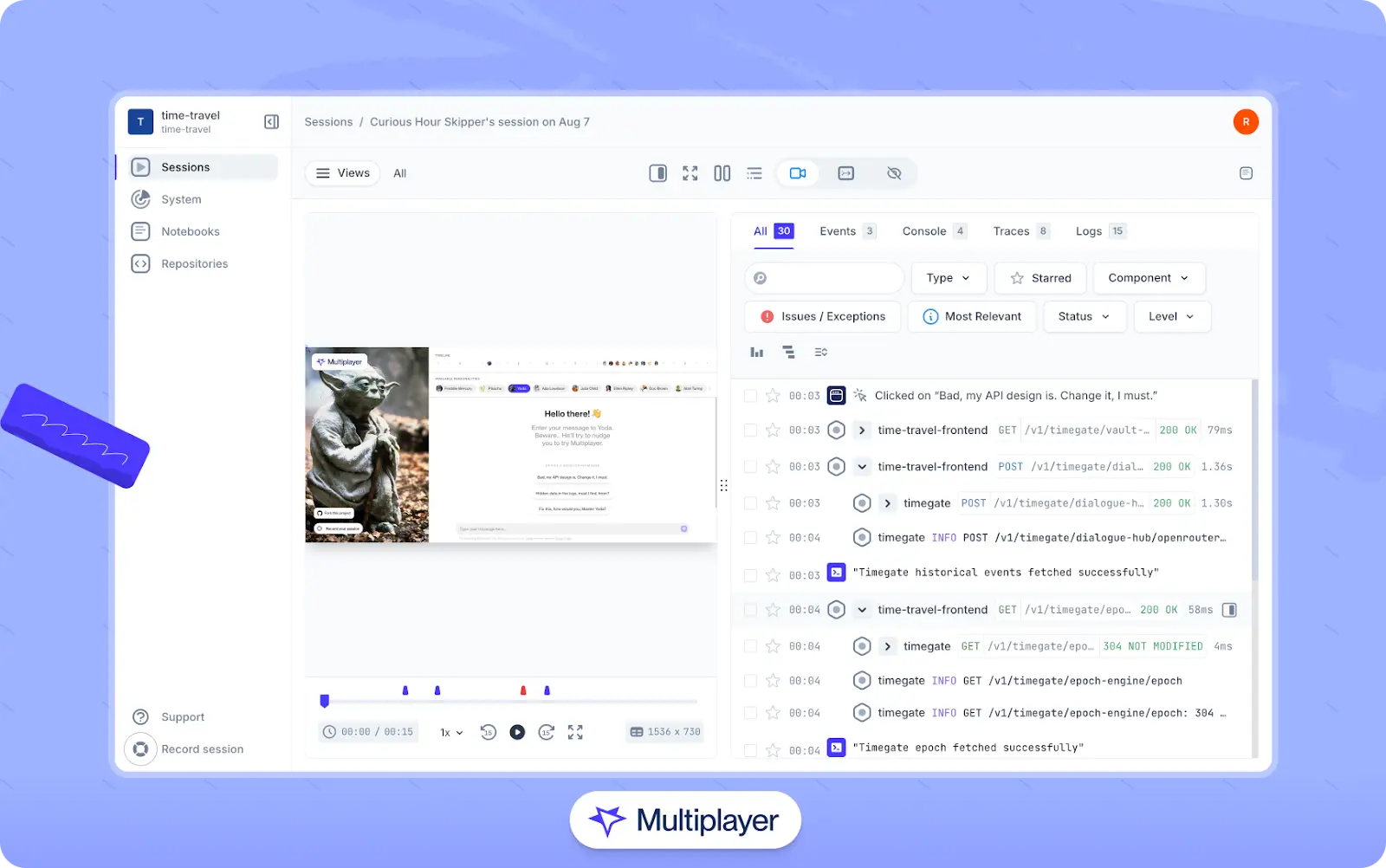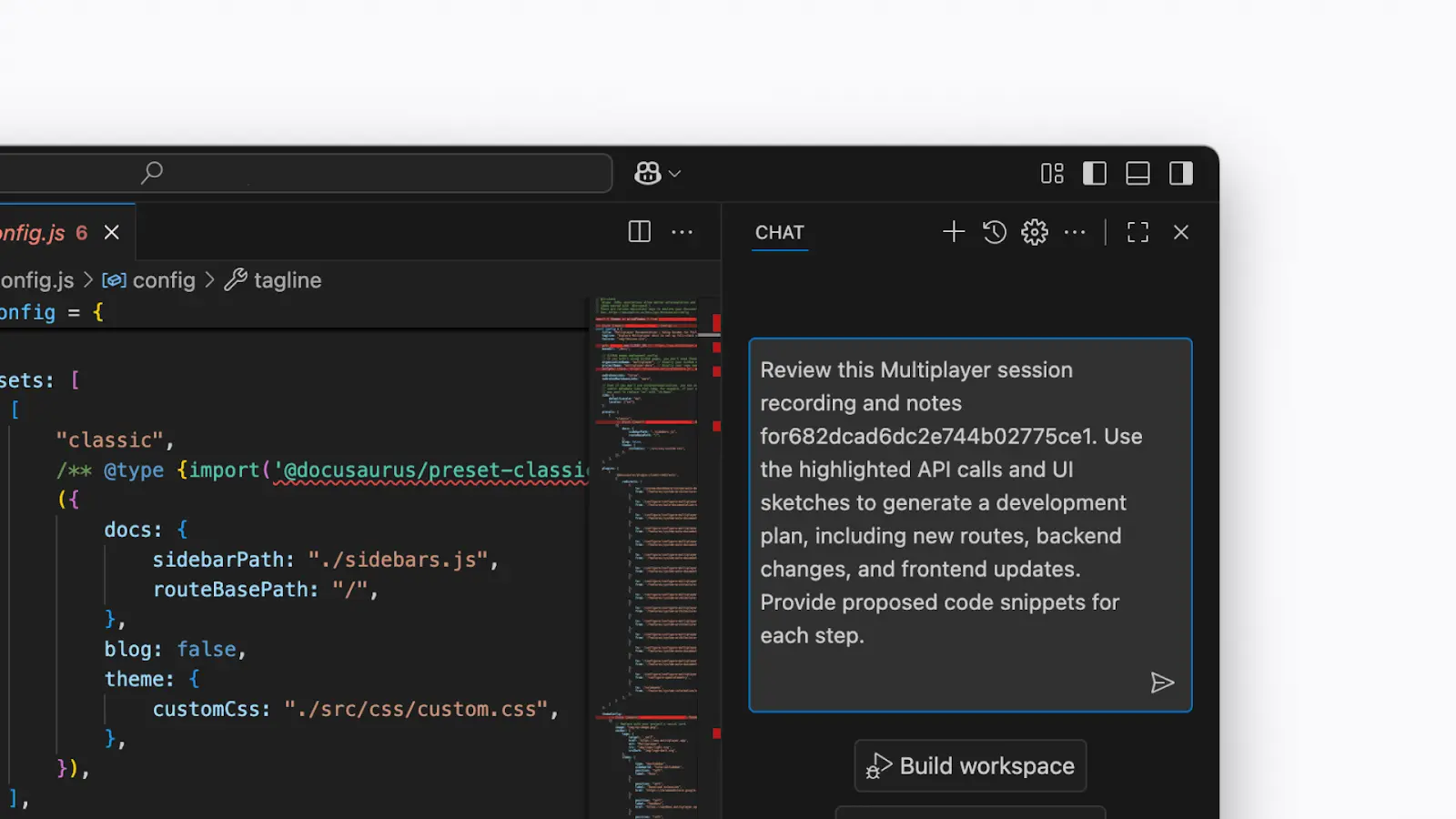Guide
Session Recording Software: The Must-Have Features
Table of Contents
Modern session recording has evolved from simple user experience tools into full-stack platforms that capture both frontend and backend data. Early session replay tools were mainly used by UX teams to observe user behavior at scale, essentially serving as "on-demand" user research to see where designs caused friction.
Today, session recordings are just as crucial for quality assurance (QA) engineers and developers. Instead of relying on sparse bug reports, engineering teams can replay real user sessions with logs, traces, and errors to quickly reproduce issues and diagnose root causes. In short, session recording has transformed from a UX aid to a cross-team necessity for debugging, testing, and product analytics.
In this article, we explore the essential features teams should look for in session recording software that serves the needs of engineering, product, and UX teams. These core capabilities act as decision criteria to help your team cut through vendor claims and focus on what truly impacts debugging, QA, and user experience.
Summary of essential session recording software features
| Desired feature | Description of capability |
|---|---|
| Full DOM and event replay | Record and replay DOM state, user input, and page changes as a video-like experience. |
| Console and error logging | Record browser logs and JS errors to help engineers debug frontend issues. |
| Network and API monitoring | Log all frontend API calls, responses, and failures to surface backend or integration issues. |
| Backend trace integration | Link session events to backend traces using OpenTelemetry or trace IDs for full-stack debugging. |
| QA and test Integration | Capture sessions from automated test runs to investigate failures with video-like playback. |
| Session searching and filtering | Filter and search by user ID, page, duration, errors, or events to quickly find the most relevant sessions. |
| Data privacy controls | Mask or exclude sensitive fields (e.g., PII) to meet compliance requirements and protect user privacy. |
| Replay collaboration and sharing | Share replay links, add comments, and embed replays in bug reports or support tickets. |
| Heatmaps, funnels, and rage click detection | Aggregate behavioral analytics such as heatmaps, funnel analysis, and frustration signals (e.g., rage clicks, dead clicks) to help product and UX teams identify drop-offs, friction points, and overlooked UI elements. |
| AI workflow integration | Connect session recordings with AI coding tools (via MCP servers and contextual editing) to provide developers with actionable insights, automated debugging suggestions, and faster triage. |
How modern session recording works
Before discussing important features to look for in tooling, let's briefly explore the concept of session recording and how it works.
DOM mutation and event capture
Unlike a literal video screen capture, modern session replay tools capture the initial structure of the page and record how it changes. They typically inject a lightweight script into the application that takes an initial DOM snapshot and then records every change (DOM mutation) along with user inputs and events.
By logging each click, keystroke, mouse movement, and UI update, the recorder can reconstruct a pixel-perfect playback of the session later. This approach is efficient and framework-agnostic: It works even for dynamic single-page applications by recording state changes rather than raw pixels. Crucially, capturing the DOM and events (instead of video) allows the replay to be interactive and searchable, and it also minimizes the performance impact on the user's device.
OpenTelemetry and full-stack correlation
Frontend capture alone shows what the user did and saw, but it does not always help developers uncover why something broke. To help developers better understand behavior across the entire system, modern session recording platforms utilize trace correlation. They propagate unique trace IDs from the browser into backend requests using standards like W3C Trace Context via OpenTelemetry. When a session triggers an API call or backend transaction, the trace ID links that frontend event to the corresponding backend logs and telemetry. This means a session replay can be paired with server-side data so that developers can see, for example, the exact database error or stack trace that occurred when a user clicked a broken button. By coupling replay with distributed tracing, engineers get end-to-end visibility for root-cause analysis.
Some tools can even visualize the entire request flow from a button click to a server-side error log in one timeline. Platforms like Multiplayer, for instance, embed OpenTelemetry IDs in each session so that a replay can pull up related backend spans and log entries for a true full-stack view.
Must-have features
We've seen how session recording captures what happens in the browser and links it to backend events. The next step is knowing which features truly provide value to different teams. Let's walk through the must-have capabilities that separate useful tools from those that fall short.
Full DOM and event replay
At the core of session recording is the ability to visually replay what the user did, which requires high-fidelity capture of the DOM state and all user interactions. The best tools record virtually everything happening in the browser—clicks, keystrokes, scrolls, SPA route changes, etc.—and recreate it perfectly. This benefits both debugging and UX review: Developers can see the exact UI state leading up to a bug, and designers can observe real user flows with all the subtle details (device, screen size, timing, etc.).
In contrast, lower-fidelity approaches that sample data or omit events will lead to "approximate" replays and risk missing key interactions. Capturing the full DOM and event stream is non-negotiable, as it's the foundation that all other features build on.
Console and error logging
When something goes wrong in a web application, the first clues are often JavaScript console errors or warnings. A modern session recorder should grab the browser's console output (console.log/debug/info/warn/error) alongside the visual replay. This lets developers see what errors were thrown at each moment of the user's journey, in context. For example, if a button click did nothing on screen, the replay might show a JS error in the console at that timestamp, saving the engineer from guessing when or where things broke.
Seeing console logs interleaved with the UI events drastically reduces the time required to diagnose issues. In fact, some commercial platforms include a "console view" in session replays specifically to surface errors "in the wild" with their stack traces. Warnings and logs can provide additional hints (e.g., deprecation messages before a failure), so capturing them is extremely valuable. In short, session replays should reproduce the browser's developer tools console for each session.
Network and API recording
Client-side errors are only part of the picture; many bugs involve failed API calls or slow network requests. A robust session recording solution logs all network activity from the browser: HTTP requests, responses, status codes, response times, and any errors. The tool should also allow developers to trace frontend symptoms to backend causes.
For instance, if a page froze while loading user data, the replay might reveal that an XHR request to /api/user never returned (or returned a 400/500 error). Engineers can inspect the timeline of network calls during playback and even view headers or payloads in some cases.
Full-stack session recording
Learn moreBackend trace integration
The next level of capability is linking the recorded session with backend monitoring data. As discussed earlier, this often involves OpenTelemetry or similar observability frameworks. The idea is that when you replay a session, you can jump directly to the correlated backend logs, APM traces, or database queries that occurred during that user's actions. This bridges the frontend-backend gap that traditionally required manually matching timestamps or user IDs across systems.
For example, suppose an error notification pops up in the UI. In that case, the session replay (with trace integration) might let a developer click a trace ID to open the exact server-side error or stack trace that triggered it.
Open-source projects like OpenReplay are useful in showing the client side. However, to get full-stack context, teams typically have to manually configure integrations by wiring session IDs or trace IDs through backend services and logs. This often means propagating trace IDs through HTTP headers, instrumenting logging middleware to include those IDs, and ensuring that every backend service consistently forwards them downstream. If a service forgets to attach the ID or logs it inconsistently, the chain of events can be broken. This requires extra setup and maintenance, and it can be error-prone if not consistently applied.
To address this, tools like Multiplayer's full-stack session recordings embed OpenTelemetry trace IDs automatically, so a replay can surface the correlated backend spans and logs without additional integration work. This built-in correlation saves teams time and ensures that every replay is full-stack by default.

Multiplayer's full-stack session recordings
When the frontend-backend integration is done effectively, the result is powerful: A developer watching a replay can seamlessly inspect database errors, cloud function logs, or performance metrics linked to that user's journey.
QA and test integration
Session recording isn't only for live user sessions; it's also extremely useful in testing and CI/CD pipelines. QA engineers increasingly capture sessions from automated test runs (e.g., Selenium or Cypress end-to-end tests) so that when a test fails, there's a video-like replay to inspect. Rather than combing through logs or trying to reproduce a flaky test locally, the team can watch the recorded session of the test and see the precise behavior. This makes continuous integration failures much faster to diagnose.
Some session recording tools offer integrations or SDKs for test frameworks to trigger recordings on test failures. Even without formal integration, teams often run a headless browser with a recorder enabled during tests. The key is that every critical test scenario should produce a shareable session replay, which becomes part of the bug report if that test uncovers a regression. This feature brings the benefits of session replay (visual context, exact reproduction of the bug) into the QA realm, greatly improving triage in CI pipelines.
Session searching and filtering
As session recordings grow in complexity, the ability to focus on specific actions or occurrences in the replay becomes vital. Manually scanning large amounts of session data to find particular events is untenable, so a must-have feature is robust event-level filtering. For example, a developer might want to quickly highlight all occurrences of JavaScript exception X within a session, every time a user visits the checkout page, or all clicks on a specific button.
Good tools provide a query interface or UI filters to let you navigate directly to relevant events and jump between them. Quickly zeroing in on relevant events saves substantial amounts of time and makes the recording an actionable diagnostic tool.
When evaluating solutions, teams should ensure that they can search by the type of event (trace, log, console, etc.), the component in which the event took place, and the level of severity (e.g., whether the event represents an informational message, a debugging diagnostic, a warning, or an error).
Interact with full-stack session recordings to appreciate how they can help with debugging
EXPLORE THE SANDBOX(NO FORMS)
Data privacy controls (masking and redaction)
Recording user sessions inevitably raises privacy concerns since sensitive user data could be captured. Any enterprise-grade session recorder must support strong privacy and redaction methods to protect user PII and comply with regulations such as GDPR in the EU, CCPA in California, or HIPAA for healthcare applications in the US.
Common approaches include input masking (e.g., auto-masking password fields or any designated sensitive fields so the actual text is never recorded) and selective recording (allowing developers to exclude certain elements or data from capture). Most reputable tools let you specify CSS selectors or use built-in heuristics to sanitize data.
In practice, teams configure their recorders to scrub content like credit card numbers, emails, addresses, or other sensitive information. Beyond masking visuals, some tools also avoid capturing keystrokes in specific fields or disable recording on certain pages entirely (e.g., a payment iframe).
Privacy controls should also extend to network data, e.g., preventing sensitive query parameters or headers from being stored in session logs. The goal is to get useful debugging info without violating user trust. When evaluating session recording software, it's important to review how it handles data privacy and ensure that it supports the needed masking rules out of the box.
Replay collaboration and sharing
A huge advantage of session replays is that they become a shared source of truth about what happened. To maximize this capability, the tool should make it easy to share and discuss sessions. This includes one-click sharing of a replay (via a link) with teammates, the ability to add comments or annotations on the replay timeline, and integrations to embed replays in issue trackers or chat.
In a typical workflow, a QA engineer may need to write steps to reproduce an issue and document the specific conditions under which it occurs. However, using collaborative session recording software, the engineer can simply attach a session link to a Jira bug ticket, so the developer resolving the bug can watch the exact failure in context. Likewise, customer support can paste a replay link into a support ticket for engineering to investigate, rather than writing a long description.
Collaboration features might include the ability to tag team members at a specific moment in the replay (e.g. "@Jane Doe, here is where the error shows up") or sketching and highlighting on the replay to point out UI issues. By unifying everyone around the concrete evidence of a session, these tools eliminate a lot of back-and-forth. Replays can also serve as a communication tool for product feedback: Product managers might share a replay snippet in Slack to illustrate a UX problem to the design team.
Finally, tools that allow end-users to add comments directly within replays when reporting issues help make user feedback less vague and more actionable. For example, a user could flag the exact step in a checkout flow where the page froze or jot down the expected vs actual outcome of a given action. This feedback, paired with the visual evidence of the session itself, reduces the guesswork for support and engineering.
In short, the best session recording software treats replays as collaborative artifacts, with permissions and tools to easily share and annotate them across QA, dev, product, and support teams.
Heatmaps, funnels, and rage click detection
While developers focus on logs and errors, product and UX teams often want to aggregate session data for broader insights. Many session recording platforms (or related product analytics tools) provide visual analytics like heatmaps, funnel analysis, and automatic frustration signals derived from the sessions. Heatmaps aggregate where users click or how far they scroll on a page, helping identify UI elements that attract attention or get ignored.
Funnel analysis uses the captured events to show where users drop off in multi-step flows (e.g., signup or checkout). Some tools can highlight "rage clicks"—instances where a user rapidly clicks something, indicating frustration—or "dead clicks," where nothing happens in response to a click. For example, Microsoft's free Clarity tool combines session recordings with heatmaps and flags metrics like rage clicks to pinpoint friction points. Smartlook (another UX-oriented platform) similarly lets you watch recordings tied directly to funnel drop-offs, so you can see exactly why users abandoned a process.
These capabilities are invaluable for product managers and designers to validate design changes and improve conversion rates. By coupling qualitative replays with quantitative aggregates, teams get a 360° view, e.g., the funnel shows 60% of users dropped at Step 3, and replaying those sessions reveals a confusing form UI causing it.
However, it is important to note that Clarity and Smartlook are frontend-only solutions; they're useful for high-level UX insights but don't provide backend correlation or trace integration. A practical solution is to utilize both frontend UX/analytics platforms and more dev-centric recorders. UX tools surface aggregate patterns, while full-stack recording tools provide detailed logs and replays. The combination ensures that insights flow smoothly across product and engineering.
One click. Full-stack visibility. All the data you need correlated in one session
RECORD A SESSION FOR FREEAI workflow integration
The newest frontier in session recording is leveraging AI to speed up analysis and debugging. As session replays capture rich context about user interactions and system behavior, they make excellent fuel for AI-driven tools. We're starting to see features like AI-generated session summaries, where an algorithm highlights the key events or problems in a long recording (useful to avoid needing to manually watch a lengthy session playback to find one bug).
On the development side, developers can feed AI coding assistants session data (user steps, console errors, stack traces) to help the assistant suggest likely causes or even generate a unit test that reproduces the bug. Tools like Multiplayer are positioning their platforms in this direction, turning session recordings into actionable tasks for AI copilots. Using these types of tools, developers can leverage AI to propose a fix, develop new features, or create a Jira ticket draft based on real, contextual runtime data.

Example AI prompt to create a development plan from a session recording
While still early in its adoption, AI integration is a natural extension of session recording. It aims to reduce human effort in triaging replays and provide actionable insights. When evaluating modern solutions, it's worth considering how they plan to incorporate AI–not as a gimmick, but as a meaningful tool to accelerate debugging and analysis workflows.
Balancing dev and UX needs
One of the challenges (and opportunities) in session recording is serving two different audiences: development teams and UX/product teams. Traditionally, these groups have often used separate tools; developers use error trackers and application performance monitoring (APM) dashboards, while UX researchers use frontend replays and analytics tools. This siloed approach means a "recorded session" for a designer might lack the information a developer needs, while the APM data developers use is of little importance to the UX team.
The reality is that both perspectives are valuable, and session recording software that supports both audiences can provide substantial benefits. For example, a product team might notice that users frequently abandon a form at a particular step, while developers can use the same replay (with backend request data and error traces) to understand why the submission failed. By removing the artificial separation, a single session replay can serve as both a source of user insight for product teams and a bug reproduction tool for developers.
Such an approach also fosters empathy between teams: Developers get more exposure to real user behavior, and designers/product teams gain insight into the technical side of user issues.
The bottom line is that neither developers nor UX teams alone should "own" session recording—it delivers the most value when it's a shared asset. When choosing a solution, ensure that it has the flexibility to support engineering workflows and product/UX decisions. Multiplayer is a prime example; it provides UX-friendly features like visual replays and user interaction history alongside dev-centric features like linked backend traces and code-level annotations. This way, session replay becomes a common ground for dev and UX to jointly improve the product.
Stop coaxing your copilot. Feed it correlated session data that’s enriched and AI-ready.
START FOR FREEConclusion
Session recording software has undergone a paradigm shift from being a purely qualitative UX tool to becoming a unified observability and usability solution. By capturing everything that happens in a user session—from clicks and scrolls to API calls and backend traces—modern platforms provide an end-to-end picture that was hard to imagine a decade ago. This unification delivers clear benefits: Developers can fix bugs faster (often without needing to reproduce them manually), and product teams can deeply understand user behavior, all using the same data instead of separate silos.
When evaluating session recording solutions, teams should keep a checklist of the key features and capabilities we've discussed. Does the tool reliably replay the DOM and user input with high fidelity? Does it capture console errors and network requests for debugging? Can it integrate with backend telemetry or at least correlate with error tracking systems? How does it handle privacy concerns like PII masking? Can you quickly search and filter sessions at scale? Does it support collaboration (sharing, commenting) and broader analytics like heatmaps or funnels? And looking forward, is it adaptable to new workflows like AI-driven analysis? These questions will help ensure you choose a solution that meets the needs of all stakeholders: QA, developers, product managers, and designers alike.
The ultimate promise of session recording is "capture once, use many times." A single recorded session can serve as a bug report, a usability study, a training example, and a data point for AI models. By combining these capabilities in one platform, organizations reduce tool fragmentation and miscommunication. Instead of spending days guessing what went wrong on a user's screen or deciphering a sparse log, teams can press "play" and see the issue through the user's eyes, with all the technical context behind the scenes. This accelerates debugging, leads to more informed design decisions, and ultimately helps build more robust, user-friendly software.
Session recording software is no longer just about watching users; it's about understanding and improving the entire system that serves those users. In an era where customer experience and system reliability are both paramount, end-to-end visibility is a true game-changer.


